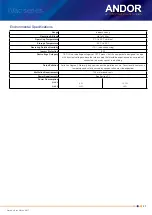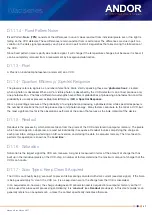
Version 2.0 rev 26 Jan 2017
34
iVac series
1
Exposure to light causes a pattern of charge (an electronic image) to build up on the frame (or
Image Area
) of the CCD-chip.
2
Charge in the frame is shifted vertically by one row, so that the bottom row of charge moves down into the shift register.
3
Charge in the frame is shifted vertically by a further row, so that the next row of charge moves down into the shift register, which now contains
charge from two rows - i.e. the charge is vertically binned
4
Charge in the shift register is moved horizontally by one pixel, so that charge on the endmost pixel of the shift register is moved into the output
node of the amplifier.
5
The charge in the output node of the amplifier is passed to the analog-to-digital converter and is read out.
6
Steps 4 & 5
are repeated until the shift register is empty. The process is repeated from
Step 2
until the whole frame is read out.
D1.6.2 - Horizontal Binning (Creating Superpixels)
Shifting the charge horizontally from several pixels at a time into the output node is known as horizontal binning.
Horizontal binning in combination with vertical binning allows you to define so-called superpixels that in Image Display
Mode represent as a single picture element charge that has been binned from a group of pixels. For example, charge
that is binned vertically from two rows and horizontally from two pixels before being read out is displayed as a superpixel
of dimensions 2 x 2 pixels.
On the one hand, superpixels (by comparison with single pixels) result in a more coarsely defined image when the data
are displayed in
Image
misplay mode. On the other hand, superpixels offer the advantages of summing data on-chip
prior to readout. In the example below, where each superpixel is of dimensions 2 x 2 pixels, charge from two rows is
first binned vertically into the shift register; then charge from two pixels of the shift register is binned horizontally into
the output node of the amplifier. The effect of the combined binning processes is a summed charge equating to a 2 x 2
‘
superpixel
’.
Since this example initially involves binning charge from two rows, the process begins in the same way as shown in
Steps 1 - 4
of
Vertical Binning of Two Rows on
then horizontal binning begins.
D1.7 - Counts
Counts refer to the digitization by the A/D conversion and are the basic unit in which data are displayed and processed.
Depending on the particular version of the detection device, one count may, for example, be equated with a charge of 10
photoelectrons on a pixel of the CCD.







































